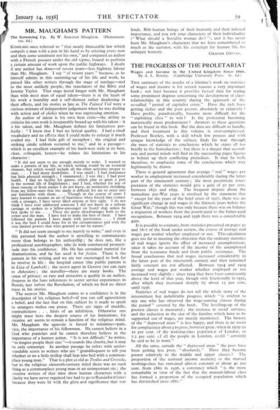THE PROGRESS OF THE PROLETARIAT Wages and Income in the
United Kingdom Since 1860. By A. L. Bowley. (Cambridge University Press. 8s. 6d.) THIS summary of the results of a lifetime's work on statistics of wages and income is for several reasons a very important book ; not least because it provides factual data for testing some prominent dogmas concerning the development of class- relationships in this country during the approach of the so-called " period of capitalist crisis." Have the rich been getting richer and the poor poorer, absolutely or relatively ? Have profits, paradoxically, become more difficult for the " exploiting class " to win ? Is the proletariat becoming numerically more predominant ? Answers to these questions can be found in this book. But the data are difficult to handle, and their treatment in this volume is over-compressed. Professor Bowley, with a skill which few possess and with unique knowledge of the subject, finds his way through the mass of statistics to conclusions which he states all too briefly in the Introduction ; but there is a danger that second- rate and partial minds will find in the succeeding pages figures to bolster up their conflicting prejudices. It may be well, therefore, to emphasise some of the conclusions which may legitimately be drawn.
There is general agreement that average " real " wages per worker in employment increased considerably during the latter part of the nineteenth century ; the most pessimistic inter- pretation of the statistics would give a gain of so per cent. between 185o and 1899. The frequent dispute about the immediate pre-War years is resolved by the statement that " except for the years of the brief crisis of 1907, there was no significant change in real wages in the thirteen years before the Great War," though this was only because there was on balance a migration of workers from the poorly-paid to the better-paid occupations. Between 1914 and 1936 there was a considerable gain.
It is possible to estimate, from statistics presented on pages 3o and 76-7 of the book under review, the course of average real wages per worker whether employed or not. This calculation goes too far in meeting the objection that the ordinary statistics of real wages ignore the effect of increased unemployment, since it takes no account of the income of the unemployed from the insurance funds and from public assistance. The broad conclusions that real wages increased considerably in the latter part of the nineteenth century and then remained fairly constant are not affected. Between 1914 and 1924 average real wages per worker whether employed or not increased very slightly ; since 1924 they have been consistently above the level of that year, though only fractionally in 1932, after which they increased sharply by about 15 per cent. until 1936.
Statistics of real wages do not tell the whole story of the intermittent but indubitable progress which " is evident to any one who has observed the wage-earning classes during the period " covered by the book. The levelling-up of the poorest classes is measured ; the increase in social services, and the reduction in the size of the families which have to be supported out of wages, are merely mentioned. The history of the " depressed areas " is less happy, and there is no room for complacency about y rogress, however great, when in 1929-3o 10 per cent. of the working-class population of London, or 7.2 per cent. cf all the people in London, could " certainly be said to be in want."
All the same, outside the " depressed areas " the poor have been getting less poor, " absolutely." Have they become poorer relatively to the middle and upper classes ? The proportion of the national income accruing to the manual working-class has remained almost constant at about 4o per cent. from 186o to 1936, a constancy which " is the more remarkable in view of the fact that the manual-labour class has formed a proportion of the occupied population which has diminished since 1880." This diminution in the proletarian proportion of the bccupied population is probably due principally to the increased employ- ment of women in ." white-collar " (or should one say " silk- stocking " ?) occupations—women who, a generation ago, would have remained in the home. Among occupied males the proportion which was middle-class increased moderately from 1881 to 1911 and thereafter only neglibly. There has probably been some ascent from the working to the middle class. "One of the main changes, shown by statistics and otherwise evident, is that lines of [class] division are being ob- literated." Whether these changes have any significance for the so-called class-struggle it is difficult to say. The relative numerical increase of the occupied middle-class is probably unimportant ; the important question is whether or not the increased numbers occupied will continue to find employment, for middle-class unemployment tends to breed Fascism.
FREDERICK BROWN.







































 Previous page
Previous page